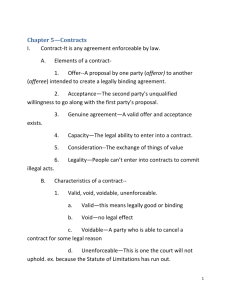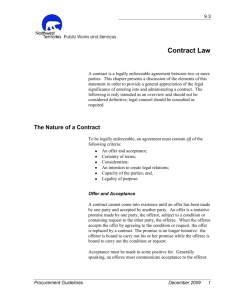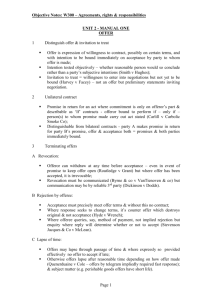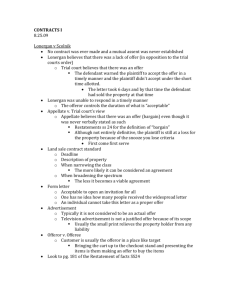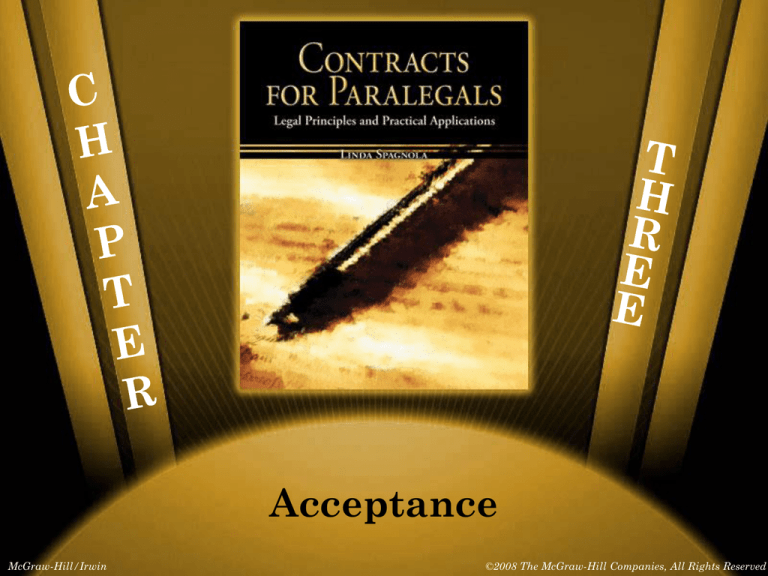
Acceptance
McGraw-Hill/Irwin
©2008 The McGraw-Hill Companies, All Rights Reserved
Objectives
Chapter Objectives:
• Use vocabulary regarding acceptance
properly
• Discuss the “mirror image rule”
• Identify where silence may be acceptance
• Evaluate the applicability of the “mailbox
rule” and how it affects acceptance and/or
rejection of an offer
• Determine if there has been a “substantial
beginning” toward partial performance of a
unilateral contract, thereby binding the
offeror
3-2
Objectives
• This chapter will explore HOW contracts are
accepted,
• WHEN bilateral contracts are accepted,
and,
• WHEN unilateral contracts are accepted
– An offeree’s acceptance must be a
mirror image of the offer, including the
means of delivering that acceptance to
the offeror
3-3
Acceptance
• Bilateral contracts can be accepted by making
a promise, that promise—once sent, in
compliance with the mailbox rule, to the
offeror—binds the parties to their
performance obligations of the agreement
• However, the parties are not bound to their
obligations until complete or substantial
performance has been rendered
3-4
Mirror Image Rule
• This mandate that the offeree accept with
only a “yes” has its basis in the mirror image
rule
• This means that the offeree’s acceptance must
mirror the offer exactly, without deviation or
modification
3-5
Mirror Image Rule
•
•
•
The offeror is the master of the offer as he
sets all the terms, the offeree is the maker of
the contract because the contract is not
formed until it is accepted. He is the “closer”
of the deal
How he closes the deal is subject to the
mirror image rule in that if the offer requests
a promise (a bilateral contract), the offeree
must accept by making the appropriate
promise
If the offeror requests a performance (a
unilateral contract), the offeree must accept
by performing the requested act
3-6
Mirror Image Rule
• Knowledge of the offer
– An offeree must be aware of the terms of
the offer in order to accept it
3-7
Mirror Image Rule
• Silence
– In certain circumstances, no response may
be necessary to properly accept an offer
– During the time in which the offer
remains open, and the offeree remains
silent, there can be no contract formed
because there can be no meeting of the
minds
3-8
Mirror Image Rule
• Mutuality of assent
− Both parties must objectively manifest
their intention to enter into a binding
contract by accepting all of the terms
3-9
Mirror Image Rule
• Acceptance of services or goods
− Where an offeree has taken possession of
the goods or received the benefit of the
conferred services, he has been deemed to
have accepted the offer
3-10
Mirror Image Rule
• Solicited offer
– Can be accepted by silence on the part of
the offeree because the offeree has such an
integral role in the shaping of the offer
that the offeree’s acceptance is essentially
redundant
– The offeree has initiated the contact and
invited the offeror to make him/her/it an
offer
3-11
Mailbox Rule
• Mailbox rule
– A principle of contract law that sets the
time of acceptance of an offer at the time it
is posted and the time of rejection of an
offer at the time it is received
3-12
Mailbox Rule
• Proper dispatch
− An approved method of transmitting the
acceptance to the offeror
− Dropping a letter of acceptance into the
mailbox (hence, the mailbox rule) is valid
acceptance of a bilateral contract and, that
the parties are bound as both have
exchanged their promises
3-13
Mailbox Rule
• The acceptance must be sent to the offeror in
the way that the offer has specified, if it has
specified any means
• The acceptance must comply with the terms of
the offer
– a prescribed method of accepting the offer
is a material term and will affect the
validity of the acceptance
– If no means of acceptance are prescribed
in the offer, the courts have determined
that any reasonable method of
dispatching the acceptance will create the
contract
3-14
Mailbox Rule
• If the acceptance is sent improperly but it is
nevertheless received by the offeror, the
acceptance is valid upon the receipt of the
acceptance
3-15
Mailbox Rule
• Unlike acceptance, rejection of the offer is
valid only upon receipt of the rejection by the
offeree
• Contract law likes to foster the creation of
contracts; therefore, it is better to assume
that the contract is still open and wait until
receipt of the rejection
3-16
Mailbox Rule
• Option contract
– A separate and legally enforceable
agreement included in the contract
stating that the offer cannot be revoked
for a certain time period
3-17
Mailbox Rule
• Reliance
– A party’s dependence and actions based on
the assertions of another party
3-18
Partial Performance/
Substantial Beginning
• Partial performance/substantial beginning
– An offeree has made conscientious efforts
to start performing according to the terms
of the contract
– The performance need not be complete nor
exactly as specified, but only an attempt
at significant compliance
3-19
Partial Performance/
Substantial Beginning
• Tender Of Performance
– The offeree’s act of proffering the start of
his contractual obligations
– The offeree stands ready, willing, and able
to perform
3-20
Partial Performance/
Substantial Beginning
• Tender Of Performance
– The tender of performance, standing at the
ready to fully perform, is the consideration
for keeping the option contract open
– It is understood that the offeror of the
unilateral contract will accept the tender
of performance and in good faith will keep
the offer open
– The offer cannot then be withdrawn until
and unless the offeree manifests an
intention not to fully perform on the offer
3-21
Summary
• Acceptance
– The manifestation of the intent to be
bound by a simple “yes,” expressed in
either words or actions, is acceptance
– Very rarely is silence considered valid
acceptance because it lacks the element of
mutuality of assent
3-22
Summary
• Acceptance
– If the offeree makes the requested promise
or does the requested act, the contract is
formed, provided that she has knowledge of
the offer
– Both parties now have legally enforceable
obligations to each other under the terms of
the contract
– The acceptance must be a mirror image of
the offer; no new terms or qualifying
conditions may be added
3-23
Summary
•Mailbox rule
– Acceptance is valid upon posting and
rejection is valid upon receipt, provided
that there has been proper dispatch of the
acceptance
– The court also will look to see if there has
been reliance on either the attempted
acceptance or rejection in order to
determine its effect upon the creation of
the contract
3-24
Summary
Once it has been determined that a
legally enforceable contract has come
into being through a valid offer
supported by consideration and
accepted by the offeree , the remaining
terms and conditions of the contract
can be examined. These additional
terms and conditions do not alter the
fact that the contract is enforceable,
they determine how and by whom the
contract can be enforced
3-25



